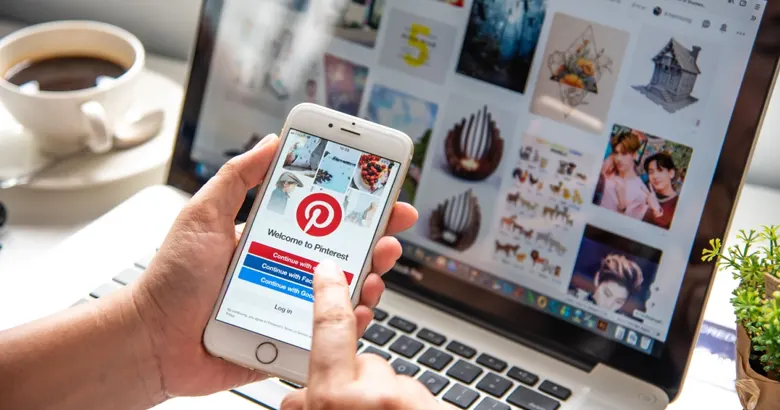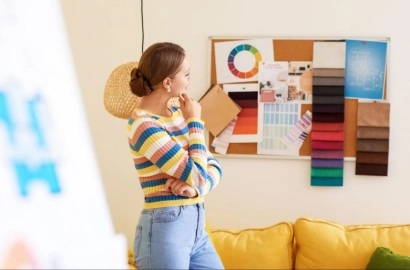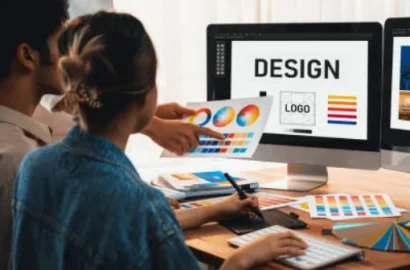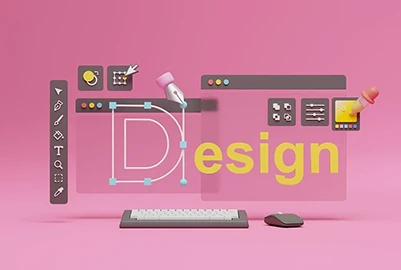Curious about social media design? Understand why it is important for brands and take inspiration from our recommended tips and examples.
Social media design may have been dismissed as a passing trend a decade ago, but today, it has changed how business is done. It gives you an opportunity to connect with your consumers and be present in their minds, whether they’re consciously consuming your content or casually scrolling. A strategic design approach can help you build relationships and ensure your brand doesn’t just exist online but actively captures your audience’s attention.
Whether you’re looking to build an online presence for your business or want to give a new identity to your current one, learning about the latest shifts in social media design trends can ease the process.
Here’s all that you’ll find in this blog:
- What is social media design?
- Importance of social media design for a brand
- Core principles for creating exceptional social media designs
- 12 proven tips for building a social media design
- Examples of companies with the best social media designs
- Final thoughts
What is social media design?
Social media design, a subset of graphic design, is a format for creating intriguing visuals around diverse content on platforms like Instagram, LinkedIn, Facebook, TikTok, and X. These visuals are categorized as carousel posts, stories, and reels developed according to content strategy. Having a social media presence for your business increases your chances of being recognized by a wider audience and allows them to experience the values that you swear by. It outlines the choices you make for your brand in terms of purpose, aesthetics, and even price points, as well as defines a brand voice associated with a visual identity.
This modern-day approach to design is a reliable way of providing your audience with an authentic and consistent experience across various platforms. For example, an activewear clothing brand should ideally focus on creating colorful social media design posts and campaigns that resonate with its brand identity. By combining eye-catching visuals, engaging graphics, typography, and short-form videos, the brand can inspire audiences to take the first step toward a healthy lifestyle. Similarly, a travel influencer might want to capture experiences through visually striking carousel posts, stories, and high-quality reels while providing practical tips for affordable or luxury traveling.
What is the importance of social media design for a brand?

Image Courtesy – Trionix Global
Social media design has become extremely important for brands, with nearly half of the global population actively engaging on at least one platform and dedicating an average of about 2.5 hours daily to content. More than half of social media users, on average, explore products and services through these platforms. The core focus of most social media platforms lies in creating attractive visuals, without which even the most well-planned marketing campaigns may struggle to succeed. Here are some reasons why social media design is becoming increasingly critical to businesses.
1. Captures attention
Social media posts often serve as the first interaction between a brand and its audience. A well-thought-out and alluring design quickly grabs attention, leaves a strong first impression, and encourages users to explore the content further. It also enables your audience to engage directly with the brand, develop a connection, and take action.
2. Builds brand awareness and recognition
While high-quality products, services, and website design are critical for any business, users are unlikely to visit a website on a daily basis. This is where social media content comes in handy and becomes a medium to keep audiences engaged and informed with regular updates. Consistent design elements like logos, brand colors, and typography help build and reinforce a brand’s identity. When users repeatedly see cohesive visuals across social media posts, it automatically increases brand recognition and trust.
3. Increases engagement
Visually engaging social media graphics can greatly enhance user interaction. When content is relevant and at the same time visually pleasing, users are more inclined to like, comment, share, or save to explore the brand further.
4. Connects with your target audience
Social media platforms are powerful marketing tools, offering advanced targeting options to reach audiences most likely to engage with your brand based on demographics, location, and preferences. While these tools ensure your ads reach the right people, professionally designed social media graphics can amplify interaction through storytelling. They can create a strong emotional connection with your audience, fostering loyalty and support while inspiring them to share your content, ultimately broadening your brand’s reach and influence.
5. Helps stand out from competitors
With endless hours spent on social media and an overwhelming stream of content, attention spans are shrinking rapidly. This makes the role of design in your social media marketing strategy crucial—it needs to grab attention and make people pause to notice your advertisement and eventually make a purchase.
Core principles for creating exceptional social media designs

Image Courtesy – Wizard of Ads
Social media revolves around content—it’s the foundation of daily interactions and the primary way to connect with your audience. However, all the effort may not make a lasting impression if the content design doesn’t captivate your followers.
The style and type of content you create should align with your brand identity, business objectives, and overall goals. That said, here are some principles you can follow to create compelling social media graphics that not only attract followers but also keep them engaged.
1. Diversify your social media designs
To establish your brand, you need to increase your visibility by being present on different social media platforms. This can vary depending on the type of business and where your target audience usually hangs out. Exposing audiences to the same content on multiple platforms potentially reinforces the message that you’re trying to convey. However, it is important to ensure that you customize your designs as per the needs of each platform in terms of size and resolution.
2. Stick to platform templates
Creating templates for different content types simplifies the process of making new social media posts. By adjusting only a few details for each post, you can save time and focus on other important tasks. Using templates aligned with official size requirements eliminates the need to worry about resizing graphics for each platform and ensures the brand’s creative persona is not tampered with. This ensures your designs won’t be cropped or distorted, preserving important information and maintaining high-quality resolution for a polished and professional appearance.
3. Focus on creating valuable content
Valuable content benefits any business that you’re trying to build online. It simply means that you’re informing or educating your audience as opposed to pushing them to buy your products or services. Social media design is significant in this process, as visually appealing and well-structured content can make your message more engaging and easier to understand. High-quality visuals, thoughtful layouts, and consistent branding encourage more shares and saves, indicating that your content is relatable and is being appreciated by consumers. It reaches more people across platforms, which potentially increases traffic to your website, showcasing the power of effective design in content creation.
12 Proven tips for building a successful social media design
Now that we’ve covered the principles to follow, let’s take a look at some tried and tested tips that can help you get started.
1. Identify your audience
Success on social media relies heavily on effective segmentation. Start by identifying your typical audience and narrowing down the specific group you want to target. Doing this will ensure your efforts are directed toward the audience that aligns best with your business goals. For example, if you’re trying to connect with a younger audience, platforms like TikTok and Instagram are ideal, while for relatively older demographics, Facebook might be a better option.
2. Create a content strategy
Stunning visuals are only effective when backed by a strategic content strategy. Even if your designs adhere to best practices, they’ll fall short without a clear purpose, engaging storytelling, well-timed execution, and other components, ultimately undermining the efforts of your team. Every company, knowingly or unknowingly, has a brand identity and visual presence on social media—though some express it more effectively than others. Having a strategy from the beginning can help you define a visual language, ensuring consistency and clarity in your online interactions.
3. Prioritize visuals
Eye-catching visuals make complex messages easier to understand, enhance content consumption, and improve retention and shareability. By incorporating diverse formats like GIFs, infographics, carousels, and videos, brands can communicate better and form stronger connections with their audience.
4. Pay attention to trends
Identifying trends and shaping opinions help you stay relevant and connected with your audience. You can keep a tab on your competitors or prominent figures in your industry to remain informed. However, it is important to keep in mind that the trends you choose should resonate with your values. Consumers are quick to detect inauthenticity, which can have a negative impact on your brand.

5. Experiment with different designs
Your posts should explore a range of topics while incorporating diverse design styles to keep your feed fresh and engaging. Bold and creative approaches can lead to significant breakthroughs. Experiment with different content formats and designs on each platform, considering brand values and audience preferences.
6. Make your designs eye-catching
Aesthetically appealing social media posts grab attention and keep readers engaged. To achieve this, combine images, graphics, and varied fonts or typefaces for visual interest. Maintain a consistent color scheme and utilize white space effectively to enhance readability.
7. Set measurable goals
Establish clear and concrete goals, such as increasing followers, boosting views, or driving shares while ensuring that your targets are realistic. Determine how to track progress and know when you’ve succeeded. Focus on KPIs (key performance indicators) that genuinely reflect engagement and set a deadline to evaluate the success of your campaign.
8. Make use of free tools and resources
You can always hire a graphic designer or a social media manager to create customized content for your business. But if you’re just starting out or have a limited budget, many free resources are available to help you create stunning social media designs.
9. Be mindful of image sizes
Using images with incorrect aspect ratios or low resolutions can lead to distortion, cropping, or poor quality—leaving a negative impression of your brand. Since every social media platform has unique image specifications, it’s crucial to adapt your visuals to fit each one.
10. Experiment with typography
Keep the word count minimal when designing for social media, whether it’s images with quotes, stylized typography, or text overlays. Try making the text bold, clear, and to the point. Ensure sufficient contrast between the text and the background for optimal readability.
11. Use automation
Leverage automation to streamline your posting process, organize your schedule, and ensure your content goes live at the best times for audience engagement. Most social media management platforms allow you to schedule posts when your audience is most active. For businesses with a multi-location presence, automated scheduling ensures your content reaches customers in various time zones.
12. Incorporate a call-to-action
If you don’t have a clear direction on what to do next, even the most visually compelling social media post design will fall flat. So, always include a concise and engaging call-to-action that clearly outlines the next step to achieve the desired outcome.
Examples of companies with the best social media designs
Before starting your sprint with social media design, take a moment to draw inspiration from the following examples.
1. Spotify

Image Courtesy – Metigy
Spotify is a music-streaming giant widely praised for its vibrant and engaging social media presence. With a lively, witty, and music-focused tone, their content often features clever wordplay, pop culture references, and interactive elements that resonate with music enthusiasts. Their bright and colorful visuals frequently incorporate album art, impressive graphics, and artist-focused content to create a fun and relatable experience.
2. Netflix

Image Courtesy – Netflix
Netflix, renowned for its streaming services and effective content, has a social media presence that’s both conversational and on-trend. They skillfully interact with their audience through humor, memes, and clever references to their most watched shows and movies. Their visuals captivate viewers with teaser trailers, behind-the-scenes glimpses, and user-generated content, striking the perfect balance between relatability and professionalism.
3. Sephora

Image Courtesy – Sephora
Sephora is a popular beauty brand whose Instagram page features premium-quality images and videos of their beauty products, often paired with bold typography and clean layouts to highlight makeup tips and tutorials. They incorporate vibrant color schemes and stylish flat lays, making their feed informative as well as visually appealing. For long-form content on YouTube, Sephora enhances its storytelling with professionally edited tutorials and inspiring narratives, using dynamic transitions and on-brand graphics. These thoughtful design elements align their products with meaningful narratives, creating an emotional connection with their audience.
4. Starbucks
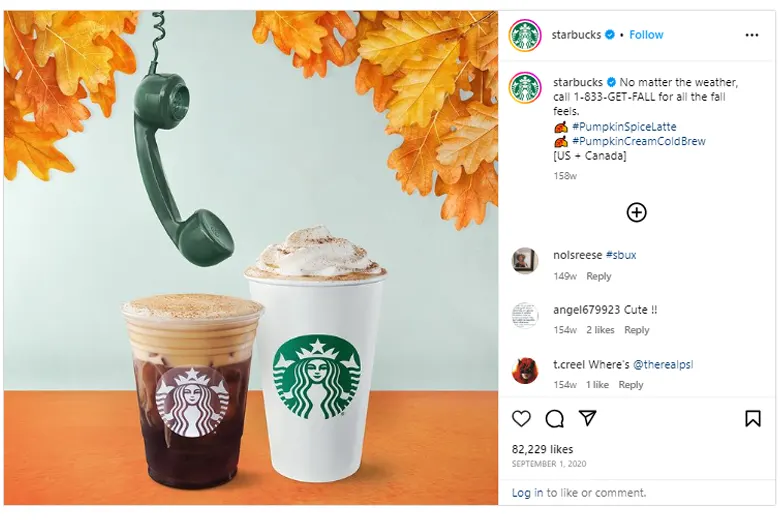
Image Courtesy – Metigy
Starbucks excels at incorporating seasonal themes or elements into their social media designs, such as festive colors for holidays or refreshing visuals for summer campaigns, keeping the content fresh and relevant for coffee connoisseurs. Their posts often place the product at the center, using natural lighting and minimalist settings to highlight the appeal of their beverages and snacks. Subtle animations and whimsical illustrations usually accompany their posts, adding a layer of fun to their overall aesthetic.
5. Mailchimp
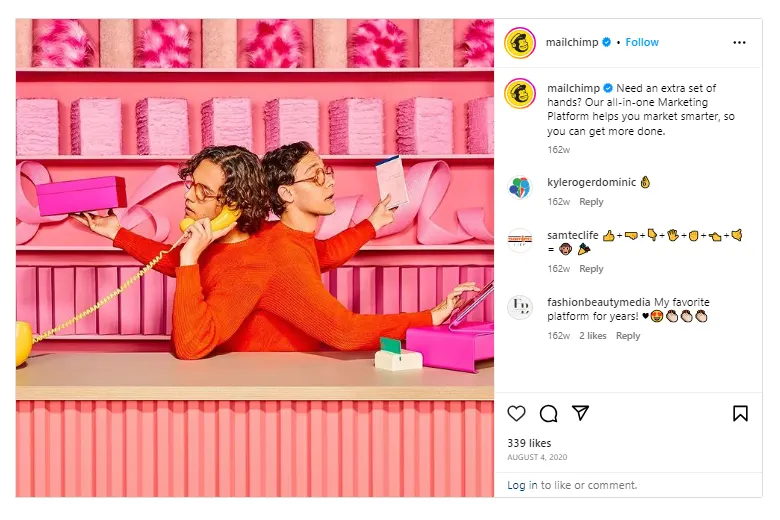
Image Courtesy – Metigy
Mailchimp’s social media content features a combination of polished static images and engaging short videos, all crafted to perfection. The designs radiate a perfect blend of professionalism and creativity without feeling overdone or amateurish. They maintain
a cohesive visual identity with consistent fonts, colors, and quirky illustrations, and integrate storytelling elements to highlight features and benefits of the platform in a relatable context.
Conclusion
We hope that this comprehensive guide has cleared most, if not all, of your doubts regarding social media design. Valuable content with stunning social media designs can get you the best results and allow you to tap into a niche audience that understands and relates to your brand.
If you’re considering learning more about graphic design and launching an exciting new career in the space, check out the Graphic Design Course offered by AND, which comes with a comprehensive curriculum covering social media design, hands-on learning opportunities, unparalleled mentorship, and dedicated placement support.
We also recommend checking out this creative social media project by AND learner Kayo Hattori for more insights.
As a starting point, you can consider going through the following resources:
12 Graphic Design Ideas and Trends To Light Up Your Next Project in 2024 (With Examples)
Graphic Designer Salary in India: Everything You Need to Know in 2024
12 Top Graphic Design Programs to Keep an Eye on in 2025
Next Steps
In case if you need further assistance, explore our resources or consider the following options to learn more about graphic design.
- Watch this session by design veteran and AND’s Academic Head, Prachi Mittal, and our Course Lead, Soumya Tiwari.
- Talk to a course advisor to discuss how you can transform your career with one of our courses.
- Pursue our Graphic Design courses – all courses are taught through live, interactive classes by industry experts, and some even offer a Job Guarantee.
- Take advantage of the scholarship and funding options that come with our courses to overcome any financial hurdle on the path of your career transformation.
Note: All information and/or data from external sources is believed to be accurate as of the date of publication.

